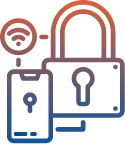Network Security Solutions
To evaluate and determine the best practices needed to secure your organization and data, we use a framework in our Service Operations Center called CIS Controls®, created by the Center for Internet Security. These controls are a prioritized set of actions that collectively form an impenetrable defense against common cyber-attacks. We use the CIS Controls® to assess your current systems, identify services needed, and deliver optimized solutions for your specific business needs.


